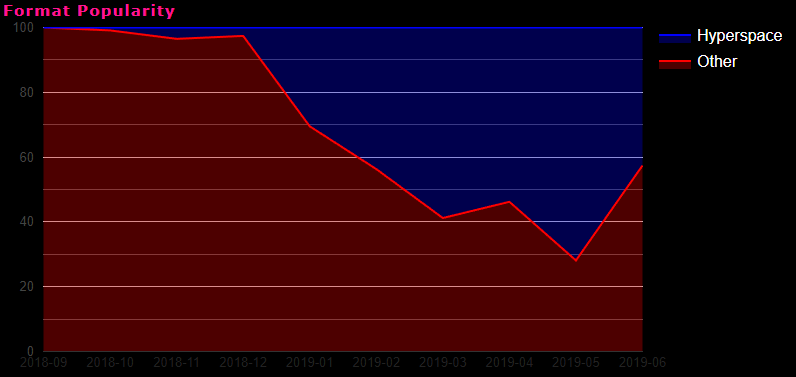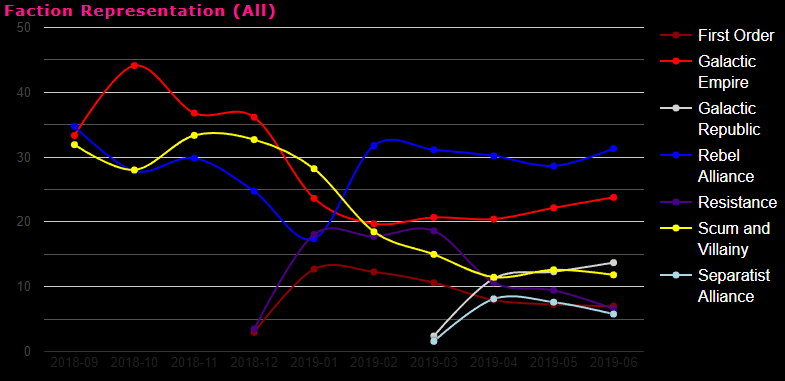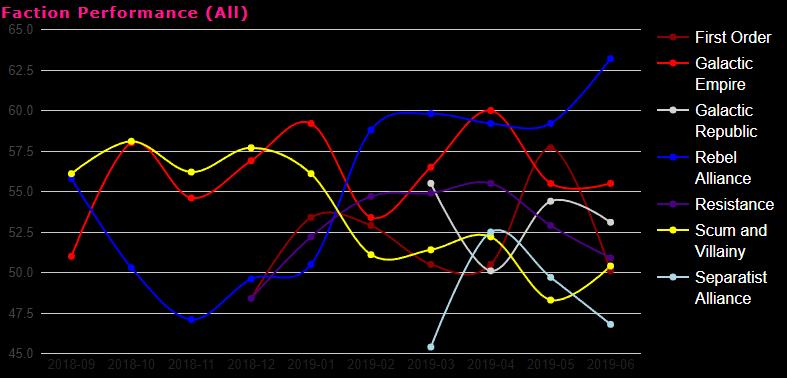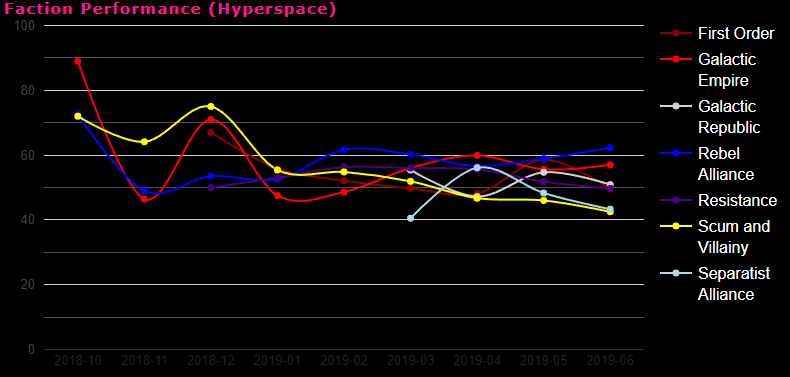We are at the brink of a substantial meta-change – not only is Wave 4 coming – but we are also very close to the second major point-change. So as I did for Wave 2 back in March, it is time to look back and see what pilots, upgrades, lists and archetypes that have shaped the last approximately 3 months. All the data here is based on data available on the 16th of June 2019.
We have a HUGE amount of data this time – 4831 lists in total. The high number of tournaments in this period means that this is almost 50% of all the listdata recorded since the launch of 2.0. 1849 lists (38%) are from extended tournaments, while 2982 (62%) are from Hyperspace tournaments.
In an attempt to focus on the more competitive meta I am, however, going to limit the dataset to the larger events. This leaves us with 1117 extended lists gathered from 7 System Opens, 1 Grand Championship (UK Nationals) and two other large extended tournaments. (MER Trophy 2019 and DEFI ALPHA CONDOR 2). (Source)
For Hyperspace, we will look at 1911 lists from 41 Hyperspace trials – all with at least 32 lists entered. (Source)
As this is an analysis piece, I will try my best to stick as close to the data as possible and avoid any personal opinion. Whenever I feel that I must interject an opinion not totally founded in data I will make sure to make an #opinion-warning 🙂
If you prefer listening to reading – and/or want more opinions – you can listen to Episode 39 of Thule Squadron Radio where I go over this article with the Thule boys.
Like I did last time I will go through the factions one by one in order of perceived strength. Don’t put too much into this order though, as this 1) is quite hard to do, 2) has been fluctuating even over the last 3 months, 3) is different between Extended and Hyperspace and 4) the factions are actually quite close.
The last bit is important. Until very late in the wave 3 meta the factions have – overall – been reasonably close. Starting sometimes in late May, the Rebels took off though. I will leave the guessing mostly to you, my own gut instinct (#opinion-warning) is that a lot of people wanted a worlds invite and “Rebel beef” was probably the simplest way to get there. There is likely also a “solved meta” effect, where it’s generally understood what works and what doesn’t.
Before we get into the faction-by-faction analysis, lets start by looking at some general tendencies.
Note: When listing percentages they refer to either faction representation (how many % of lists in that faction is this and this archetype or has that specific pilot) or average performance (100% meaning it placed first at all events it participated in, 50% being average)
General
Bid: At the end of wave 2 we had an average bid of 2.3p and the great bidding wars of wave 1 was almost all gone. Extended is now on 2.4p – while Hyperspace is at 2.6p.
The “bidding war” in both formats are driven by squads that have at least one I6, and an “average initative” of between 5 and 6. Some deeper bidding also happends for lists with an average between 4 and 5 – but again with an i6 present.
For lists without an i6, bids higher than 5 points are extremely rare.
Note that about half the lists for both Extended and Hyperspace have an I6 in them though.
List size: The number of ships in each list remains at 3.7 for Extended, and sees a small rise in Hyperspace from 3.8 to 3.9.
Details on the split of squadsizes can be seen below. As you can see, the squad sizes of Hyperspace is much more varied, and a non-trivial part of the meta (~20%) is 5+ ships.
| #ships | Hyperspace | Extended |
| 2 | 5,4% | 6,4% |
| 3 | 32,0% | 36,6% |
| 4 | 41,5% | 44,0% |
| 5 | 11,8% | 7,5% |
| 6 | 7,0% | 4,0% |
| 7 | 1,9% | 0,9% |
| 8 | 0,3% | 0,6% |
Format: Hyperspace has been the most popular format by far, though the large concentration of System Opens in the first half of June has moved the needle below 50% for that month specifically.

Faction split: The graphs below show the representation and performance of the different factions respectively. These graphs are for “all” – i.e. cross-format and not limited to the large tournaments.


Looking at the Performance graph above, we see the extreme rise of rebels in June, that I mentioned in the beginning. We also see that the spread from best to worst is greater than ever. One way to interpret this is that we have a historically unbalanced meta – but I think (#opinion-warning) that this is much more likely to be the typical pattern for a “solved” meta – especially as nothing has changed (points, releases etc.) that justifies the performance-change between May and June. First order, for example, goes from being second-best to being second-worst from May to June – and the most logical explanation is that the best First Order players simply switched factions and jumped on Rebels or Empire. (#opinion-warning)
There is one final graph I want to show before I get into the faction-by-faction analysis – and that is the Performance graph again – but this time just for Hyperspace lists.

This looks more balanced. Note the scales on the left are different though – which actually means that Hyperspace is LESS balanced. We can also see that while Rebels and Empire are good in both formats – the others are only really competitive in one of them. (Scum is decent in extended, but bad in hyperspace)
But lets get on with the faction breakdowns. This time I will focus more on “archetypes” rather than pilot-by-pilot analysis I did for wave 2. I will try to deal with Hyperspace and Extended together to keep this post to a reasonable length. Please feel free to leave a comment below and let me know which format you prefer.
Rebels remain on top
While wave 2 Rebels succeeded on the back of the Y-wing/Turrets/Gunner point reduction, the rebels are now dominated by “Rebel beef” – or as the PBM archetype is called “4 ship Rebel Joust”.
4 ship rebel joust: With the most popular form being Wedge/Braylen/Ten/Cassian, this archetype has been very effective. In Hyperspace it accounts for more than half of rebel squads, and about 17% of the total meta. In Extended, it is slightly more than a third of the rebel squads, and about 12% of the total meta.
Overall performance is 62,1% in both Hyperspace and Extended – with the Wedge/Braylen/Ten/Cassian variant reaching 77,6% in Hyperspace and 66,9% in Extended. Specifically for Extended, the best performing variant that has a significant number of results actually replace Ten Numb with Biggs – this reaches 77,7% performance. Particularly in Extended a large number of variants can be found, many of whom have good results.
Han+Jake: This archetype is interesting as it caused a lot of debate when Jack Mooney won the UK System Open with “Handbrake Han”. Discussion ensued about whether or not the entire game was broken – but if we look at the data we actually don’t see a lot of other great results. The original form in Extended is present just 9 times in the dataset – and with a sub-par performance of 54,1%. A number of other builds with Han have been attempted, but apart from a few singular results (which have been great) – it is not a list that have made a large meta impact and is consistently winning. The variant with Han/Jake/Norra (ARC-170) have fared better and averages 73,2% with 6 entries.
In Hyperspace Han/Jake has 6 entries averaging 47,2% – and a version which adds Wedge has 14 entries averaging 59,0%.
Quad K: Four Warden Squadron pilots have made quite a splash in Extended. It is quite rare – making up just 1,4% of the meta with 16 entries. The performance is great, however, averaging 77,3%
Empire rises to #2
From 3rd place back in wave 2, Empire has made a comeback, particularly in the Hyperspace format, where the inclusion of both the bomber and the interceptor has led to new options for imperial listbuilding. In general the imperial meta is quite varied, and there are many things worth mentioning – so I will keep each relatively short.
Quad Phantoms: While Quad Phantoms have been a thing in both wave 1 and wave 2, they are still very much around and winning. Accounting for 6,4% of the meta (72 entries) they have an average performance of 72,4% which puts them near the top. (Though not as high as Quad K or the Wedge/Braylen/Ten/Cassian variant of 4 ship Rebel Joust.)
The variant with Vader + 3 Imdaars has 11 entries, averaging 70,5%
Imperial Aces: This archetype, which is defined as 3 imperial ships at I5+, is about 3% of the Extended and 2,6% of the Hyperspace meta.
For Extended, the most succesful list is Vader/Soontir/Whisper – 29 entries, averaging 61,0%. In Hyperspace we see Vader/Soontir/Duchess (41 entries, 59,0%), Vader/Soontir/Vermeil (32 entries, 53,3%) and Vader/Soontir/Maarek (9 entries, 65,6%).
As a separate archetype in Hyperspace, we find two aces and two blockers – typically Vader/Soontir and two bombers with 28 entries and 60,8% performance. This squad does not seem to get much play in Extended (3 entries, 47,7%)
Hatchetman: Vader/Vynder/Jendon has made quite a splash late in wave 3, primarily due to decently good matchups vs Quad Phantoms. Like Han/Jake, however, the numbers show most results being mediocre, 28 entries and average performance of 54,0%
Inferno Swarm: TIE-swarms built around Howlrunner and Iden Versio have made significant impact in Hyperspace with 79 entries averaging 60,5%. This is 4,1% of the total meta – so 1 in 25 lists is a TIE swarm in Hyperspace. (For extended it is 1,3% of the meta, averaging 62,6% performance)
The Republic is 3rd
While not played that much (12,3% in Hyperspace, 5,8% in Extended) – the Republic has seen some good results.
Two Jedi + 2 Torrents: Anakin and 2 Gold Squadron Troopers backed up by either Mace or Ahsoka is by far the most common list in this faction. Mace is the more popular choice with 29 entries in Hyperspace and 15 in Extended, scoring 57,9% and 57,5% respectively.
With Ahsoka we have 17 entries in Hyperspace scoring 53,5%. In extended there are only 3 entries, which is too little to be relevant.
Two Jedi + 1 ARC: Only seen in significant numbers in Hyperspace, Anakin/Mace/Wolffee has 13 entries scoring 52,1%
There are a lot of other things being tried, but the number of entries for these lists are too low to reach any conclusions from. “Triple Jedi” is worth watching I think. #opinion-warning.
Resistance is best-of-the-rest
Resistance is the best of the next three, though they are extremely close. The faction has seen a rapid decline in both representation (from 22% to 6,6%) and performance (from 55% to 51%).
5 RZ-2 A-wings: Various configurations of this list have been seen – so many in fact that I will just process them all as one. This archetype makes up 1,8% of the Hyperspace and 1,6% of the Extended meta. Average results are 61,3% (Hyperspace) and 59,9% (Extended). Noteworthy, however, is the very high standard variance for the archetype, which is usually an indication that player skill is a key component to success with this squad.
Resistance 5s: Nien/Ello/L’ulo/Tallie is the most played Resistance list in both Hyperspace (38 entries) and Extended (26 entries). Performance is 49,1% (Hyperspace) and 63,8% (Extended) – and as with the 5A’s – there is indication that player skill is an important element here. The significantly better performance in Extended is also interesting.
Poe/Nien/L’ulo: Still hanging on after being quite popular in Wave 2, this list has 16 entries in Hyperspace (62,4% performance) and 9 in Extended (33,9% performance).
Scum takes 5th
Scum is, more than any faction, very different in Hyperspace and in Extended. So quite a lot of lists to go through, as there is no real overlap. I will just list them out below, starting with Hyperspace:
Boba/Emon – Hyperspace: 23 entries, 47,2%
Fenn + 3 Zealous recruits – Hyperspace: 15 entries, 52,9%
Boba / Guri – Hyperspace: 14 entries, 53,2%
Boba / Fenn / L3-37 – Hyperspace: 12 entries, 55,8%
Noteworthy for all four variants above is the high variance, implying that a skilled player can take them much further than an average one.
Drea+3 Lok Revenant – Extended: 30 entries, 66,0%.
Ketsu / Old Teroch / Talonbane Cobra: – Extended: 10 entries, 62,3%
The two extended lists also have quite a lot of variance in the results
First order is at #6 – right now at least
First order performance has swung up and down during wave 3. The faction reached #2 in May, but is #6 in June.
Kylo / Tavson / Other Upsilon: The most popular First Order archetype. In Hyperspace we have 21 entries with Starkiller Base Pilot as 3rd ship, scoring 59,9%, and 11 with Petty Officer Thanisson scoring 65,2%. In Extended, only the version with Starkiller Base Pilot reaches some statistical significance with 10 entries scoring 49,0%
Quickdraw / Silencer / Tavson: This archetype has either Kylo or Blackout as the Silencer.
The Kylo version is 55,7% for 11 entries in Hyperspace, and 67,7% for just 6 entries in Extended. (Warning: 6 is not a lot)
The Blackout version is 51,9% (11 entries) in Hyperspace and 60,4% for just 5 entries in Extended (Again: 5 is not a lot to base anything on)
Separatist ends up last
Being last in both representation and performance, there is not a lot of data for Separatist. I will only be looking at Hyperspace results here, as the numbers there are firm enough.
Double Infiltrator: Dooku and Maul have 20 entries, scoring 47,8% – but with quite a high variance. This list has won at least one Hyperspace Trial.
Wat + 6 Vultures: 12 entries, 60,1% – the most succesful Separatist list so far on average.
Double Infiltrator + Grievous: 10 entries, 51,1%
Maul + 5 Vultures: 10 entries, 56,9%
As a final note on the Separatists, there is a lot of variance in the lists. The Trade Federation Drones are the more popular option over the Separatist Drones, and they also perform better on average (54,2% vs 46,2%)
Looking at the Infiltrator, Dooku (49,5%) is the better performer, while Maul (44,4%) is much more frequently played. Maul is, in fact, the most used pilot in the entire faction, being in 56,8% of all lists, just edging out the Trade Federation Drone at 55,4%.
As far as the Belbullab goes, Griveous is most popular, but worst (40,8% performance). Wat (49,8%) and Sear (54,7%) are doing decently.
Final words
I hope you found all this useful. If you have (civil) comments, questions or suggestions please put them below. I am particular interested in hearing whether this more “list focused” approach is better or worse than the pilot-centric approach I used for the Wave 2 article.
If you want to see pilot stats you can find them here for Hyperspace and here for Extended.
Funny. I guess I skewed the stats by placing 2nd with Kylo Tavson QD at MER Trophy 2019. Got lucky, I guess 🙂
In my experience there is no such thing as “luck” 😉
I think First Order is very viable if you have the skill to fly it – but also that a lot of the people that do decided that some of the other factions were easier/more likely to get good results with.
I’m not understanding the performance scale. You said 100 is winning every event and 50 is average, but in the third graph above (performance by faction over time), six of the seven factions are performing above average most of the time. The next graph (where the factions all seem to fluctuate between 40 and 60) makes a lot more sense.
I understand your confusion. The reason here is that we don’t have data on all lists. There is a general tendency for it being more likely that lists are submitted by players with better results. That alone puts the “mid-point” of the lists slightly above 50%. The graph you point to being particulary “off” (The one with 6 factions being over 50) is the one that contains all wave 3 data – in particular the data for the UK SoS (https://listfortress.com/tournaments/557) which has 562 players but only 183 lists are known – including all the cut (65 players). Same thing for UK Nationals (195 players, 50 lists), Malmö SOS (91 players, 29 lists) and Bologna SoS (150 players, 28 lists)
The root cause for this lack of lists is both that the larger european tournaments do not use tournament-software that includes the lists (Like BCP does) – an in most cases the data has not been released by the tournament organizers due to the European GDPR rules.
The graph that seems to make more sense is for Hyperspace only – and for those events we tend to have more data – even for European events, as they are more frequently run by individuals who do not have to fear a GDPR fine. (Up to 4% of global revenue, which would really hurt Asmodee if they got that)
Hope that makes sense.